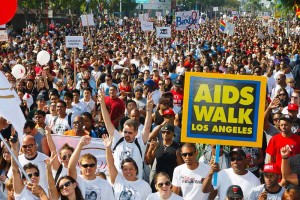USC continues to be leader in AIDS research
With 30 years of AIDS and HIV research in the books, the Los Angeles and USC communities hope to stay at the forefront of research development through community involvement and a continued strive toward treating the disease.

Cause · On Sunday more than 30,000 people, including local politicians and celebrities, took part in the 27th annual AIDS Walk Los Angeles in Hollywood. - Photo courtesy of Brian Lowe
This much was clear Sunday as an estimated 30,000 people walked the streets of Hollywood as part of AIDS Walk Los Angeles. Participants included community members and USC leaders in the field of AIDS research and development.
AIDS Project Los Angeles Executive Director Craig E. Thompson said although USC has been heavily involved in treating HIV/AIDS patients, it was not until the last decade that USC increased its focus on AIDS research.
“As a research university, USC has always been slower to move into doing HIV and AIDS research than some of the other universities, but is really stepping that up now and we are really pleased to see that,” Thompson said.
The USC community has had strong involvement in research concerning the disease ever since Michael Gottlieb, then a 33-year-old assistant professor at the UCLA medical center, first described AIDS in 1981.
Today, more than 30 million people worldwide live with either HIV or AIDS, according to a study by AVERT, a worldwide AIDS and HIV charity.
To commemorate the 30th year of strong academic and medical attention to the disease, the USC Center for Regenerative Medicine and Stem Cell Research hosted a daylong symposium last week where doctors from USC and other universities around the country discussed the future of research in the field.
USC’s increased recognition of the importance of the disease in the research community signaled to Rep. Adam Schiff that USC, and other universities, will take a leading role in the years to come.
“Some of the most path-breaking research is done at our institutions of higher learning,” Schiff said. “So USC just needs to keep up the great work it’s doing, and at the Federal level we need to make sure that the funds for research at [the National Institute of Health] are continued and continue to support the pipeline of brilliant work being done at USC.”
Student groups at USC are also looking to the USC community as a place for support for AIDS research and patients. Connie Chen, a junior majoring in international relations (global business) and president of the USC chapter of Face AIDS, an on-campus AIDS support organization, sees a bright future for involvement at USC.
“There is a lot of interest in AIDS groups [at USC],” Chen said. “It’s just so easy to get involved.”
Face AIDS also recently partnered with APLA to help increase awareness and support opportunities around USC.
For Thompson, with the changing demographic of the AIDS epidemic and USC’s geographic location, the university is poised to stay at the forefront of the fight against the disease.
“USC [is] uniquely positioned to take a leadership position in South Central. [It] has not been the hardest hit [community], but the epicenter [of the AIDS epidemic] is moving to South Los Angeles,” Thompson said. “USC could be poised to do more with services and things out of the campus or related to the campus because Jefferson Park is right there.”
